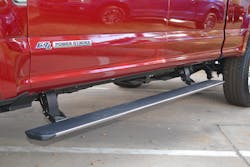University of Extrication: Pickup Truck & SUV Skills Refresher - Part 4
Topic: Pickup truck and sport utility vehicle (SUV) refresher
Objective: Pickup Truck and SUV stabilization update
Task: Given a late model pickup truck and/or SUV equipped with running boards, the rescue team will determine methods to adapt their vehicle stabilization techniques accordingly.
We continue our rescue skills update of pickup trucks and SUVs by looking at stabilization challenges responders could encounter when the crash-damaged vehicle is equipped with side running boards.
When we speak of running boards, we are talking about the steps or flat platform positioned and running parallel to the side of the vehicle below the rocker. Running boards provide a means of stepping into or out of a high-ground clearance vehicle, such as a pickup truck or SUV.
Permanent vs deployable
Although there are many different designs and styles, from a rescuer’s perspective, running boards can be classified in two categories: a fixed, permanent-mount, rigid design or a deployable style that moves into position when needed and stows away by folding back under the rocker of the vehicle.
For rescuers, there is a significant difference between the fixed running board and a deployable one. The fixed design is typically a more stable platform—a component that we might consider useful when stabilizing one of these vehicles at a crash scene. The deployable designs have movable hinges, swivels or pivot points that make the running board weak and not trustworthy. Deployable running boards are also generally made of lighter-weight materials, making them less capable of supporting the weight of the truck or SUV. A deployable running board typically will not be acceptable to use during our stabilization efforts.
Stabilization techniques
When assigned to stabilize a crash-damaged vehicle that has running boards, the rescuer must initially assess the running board. The impact itself might have already crushed or crumpled the running board, making it unusable. If it is intact, you want to determine if it is a fixed or deployable running board and if it is of lightweight or heavy-duty construction.
With deployable running boards, stabilization cribbing and/or step chocks are best positioned so they directly contact the rocker or frame of the vehicle and do not contact the running board. Ideal locations are in direct contact with the rocker directly below the A-, B- and/or C-pillars.
With a sturdy, fixed running board, consider placing stabilization step chocks or cribbing directly in contact with the running board at any point along its length. To make sure this is a good decision, remember to look at the overall construction of the running board, paying attention to where and how it is secured to the vehicle and how the running board itself is constructed.
With a fixed design, the points where the running board is mounted to the rocker or frame of the vehicle is the preferred location to place step chocks or cribbing, especially if these locations are also below the pillars of the vehicle.
The ultimate question to ask yourself is this, “Is this point strong enough that I could actually lift the vehicle if I had to? If the answer is yes, then you found a good strong point and can trust it. If the answer is no, then you should place your stabilization cribbing or step chocks at a more substantial location.
Crews can conduct rescue preplanning by studying various running board designs on member’s vehicles or during a visit to a new car dealership. Doing this now will better prepare the rescuer for making on-the-spot decisions at a crash scene when determining how to stabilize a vehicle that has running boards.
SIDEBAR:
Stabilization of a Vehicle with Running Boards
- Chock tires to prevent forward/backward movement
- Determine fixed or deployable design, sturdy or lightweight construction, damaged or undamaged
- For fixed and sturdy: Place cribbing along the rocker and/or directly in contact with running board
- For deployable and lightweight: Avoid the running board. Block directly to the rocker to support the vehicle weight
- Deflate tires to settle the weight of vehicle onto step chocks, cribbing or struts
About the Author
Ron Moore
RON MOORE, who is a Firehouse contributing editor, recently retired as a division chief with the McKinney, TX, Fire Department and now serves with Prosper, TX, Fire Rescue. He self-published the Vehicle Rescue 1-2-3 training manual and serves as the forum moderator for the extrication section of Firehouse.com . Moore can be contacted directly at [email protected].

